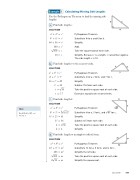Page 572 - Algebra 1
P. 572
Example
1
Calculating Missing Side Lengths
Use the Pythagorean Theorem to find the missing side lengths.
6 c 8
a. Find side length c. SOLUTION
a2 + b2 = c2
82+62 = c2 64+36 = c2 100 = c2
√ 10 0 = c 10 = c
Pythagorean Theorem
Substitute 8 for a and 6 for b.
Simplify.
Add.
Take the square root of each side.
Find side length t to the nearest tenth. SOLUTION
Simplify. Because c is a length, c cannot be negative. The side length c is 10.
b.
a2+b2 = c2 42+t2 =72 16+t2 =49
t2 =33
t = √ 33 t ≈ 5.7
c. Find side length k. SOLUTION
t
4 7
k
5
Pythagorean Theorem
Substitute 4 for a, t for b, and 7 for c. Simplify.
Subtract 16 from each side.
Take the positive square root of each side. Estimate; round to the nearest tenth.
a2 + b2 k2+52
k2+25 k2
k k
= c2
= (√ 61 )2
= 61
= 36
= √ 36
= 6
Pythagorean Theorem √61 Substitute k for a, 5 for b, and √ 61 for c.
Simplify.
Subtract 25 from each side.
Take the positive square root of each side. Simplify.
Hint
Recall that (√a )2 = a for a ≥ 0.
d. Find side length m in simplest radical form. SOLUTION
m
a2 + b2 = c2 122+82 = m2 208 = m2
√ 20 8 = m 4 √ 13 = m
Pythagorean Theorem
Substitute 12 for a, 8 for b, and m for c. Simplify the left side.
Take the positive square root of each side. Simplify the square root.
8 12
Lesson 85 557


